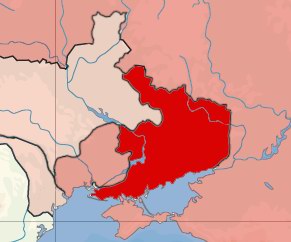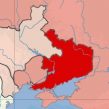
A Brief Look at the Historical Parallels Between Ukraine’s Situation in 1918 and 2014
Publication: Eurasia Daily Monitor Volume: 11 Issue: 151
By:

One hundred years ago, World War I erupted on the European continent, ultimately leading to the fracturing and collapse of the multi-national Austro-Hungarian, German, Ottoman and Russian Empires. However, out of the rubble of the old Romanov state, the Bolsheviks managed to cobble together a new imperial, multi-national entity—the Union of Soviet Socialist Republics (USSR)—though at the cost of a bloody fratricidal war and millions of human lives.
Right from the outset, the Soviet authorities placed a special emphasis on Ukraine. “There is no Russia without Ukraine. Russia cannot exist without Ukraine’s coal, iron, ore, bread, lard, Black Sea…” Leon Trotsky instructed Ukrainian communists in December 1919 (hai-nyzhnyk.in.ua, accessed August 15).
Ukraine’s political leadership rejected this Soviet domination, however, and declared the independence of the Ukrainian People’s Republic (“Ukrayinska Narodnia Respublika”—UNR) from Communist-controlled Moscow on January 25, 1918. Just one month later, on February 12, pro-Kremlin Bolsheviks gathered in Kharkiv’s Metropol Hotel to proclaim the so-called Donetsk-Krivoy Rog Soviet Republic (DKRR). The DKRR and its successor, the Ukrainian Soviet Republic, played out their roles in the Kremlin-written scenario to first break down and then fully occupy independent Ukraine.
Nearly a century later, the overthrew of former president Viktor Yanukovych’s kleptocratic regime by the EuroMaidan street protests (commonly referred to domestically as the “Ukrainian Revolution of Dignity”) has cleared the way for Ukraine to decidedly move forward on European integration. The Ukrainian nation has thus rejected being locked into Russia’s exclusive sphere of influence; and feeling threatened by this, Moscow has fallen back on its old tried methods.
Indeed, the historical DKRR today serves as a model for the Kremlin’s political “technologists” on how to undermine an independently oriented government in Kyiv. Little appears to have changed in Moscow’s strategy from 1918 versus 2014. And even the rhetoric espoused by the self-appointed “prime ministers,” “ministers” and “speakers” of the so-called Donetsk and Luhansk People’s Republics—engaged in a Russia-backed separatist war against the Ukrainian central government—echoes strongly of their early Soviet predecessors.
In 1918, the DKRR leadership labeled the UNR government in Kyiv as bourgeois and nationalistic. At the same time, DKRR leaders, such as Artyom (Fyodor Sergeyev) and the notorious Klim Voroshylov, made no secret of their political program—to nationalize coal mines and steel mills, dissolve joint-stock companies, etc.—or of their ultimate goal to retain all at least part of Ukraine within Russia. Almost a hundred years later, the new Moscow-backed proxy states’ bosses continually sound just like their 20th century DKRR predecessors, not only in terms of their Ukrainophobia, but also in the primitive and deceiving, yet socially attractive, demagogy (Zbruc, June 25). The Kremlin-installed authorities in Crimea—later fully annexed by Russia—even openly declared plans in March 2014 to nationalize the Ukrainian Chornomor Naftohaz (Black Sea oil and gas company), the Crimean branch of Naftohaz Ukrainy (see EDM, March 21).
At the same time, the political opening that allowed the Moscow-backed separatist movements to emerge in 1918 as well as 2014 was, in both cases, caused by deleterious state policies of the respective Ukrainian governments. “The behavior of the Party of Regions and Yanukovych [between 2010 and 2013] resembles that of the Denikin troops [Russian nationalist and monarchist forces of the White Army commander Anton Denikin] in Ukraine in 1919–1920,” writes Ukrainian historian Pavlo Hai-Nyzhnyk. “Back then, the Ukrainian issue, language and the people’s will were completely ignored. The Denikin army’s punitive detachments fought against everything Ukrainian. They unleashed terror in Kyiv and Kharkiv. Still, they were genuinely Russian, external forces,” Hai-Nyzhnyk argues, whereas the similarly divisive policies of the Yanukovych regime, according to the Ukrainian historian, were came from Ukraine’s very own government (Gazeta Po-Ukrayinsky, December 6, 2013).
Another common factor across both historical periods has been the split among the Ukrainian political elite. In the early 20th century, the Ukrainian national movement splintered right after the February 1917 Revolution in Saint Petersburg, which overthrew the Tsarist Russian Empire. One of the Ukrainian leaders, Volodymyr Vynnychenko, who espoused radical socialist views, saw Ukraine as an autonomous part of a would-be federal Russian republic, whereas Mykola Mikhnovsky called for Ukraine’s complete independence. Instead, both sides were supplanted by Pavlo Skoropadsky, a hereditary Ukrainian nobleman and former Russian army general, who mounted a German-backed coup d’etat and declared himself a Hetman of the Ukrainian State on April 29, 1918.
An old Ukrainian proverb says: “Where there are two Ukrainians, there will be three hetmans.” And it seemingly proved to be correct once again following Viktor Yushchenko’s presidential tenure (2005–2010), when a ruinous political dispute between him and his former Orange Revolution ally, then-prime minister Yulia Tymoshenko, enabled Yanukovych’s electoral victory in 2010.
In spite of his attempts to set a balanced policy for the fledgling Ukrainian state in 1918, Skoropadsky tended to favor large landowners, industrialists and bankers, while also catering to the demands of the German occupying forces. Importantly, however, he failed to effect popular (first of all, agrarian) reforms, forever marring his historical legacy. Similarly, President Yushchenko, who equally privileged oligarchs and did not manage to carry out any of the announced and long-expected reforms, ended up being a bitter disappointment for many Ukrainians who had supported him during the Orange Revolution in 2004–2005.
Having created a precedent for overthrowing legitimate authorities, the authoritarian Skoropadsky himself ultimately fell victim to an armed uprising, which was provoked by his plan (revealed on November 14, 1918) to federalize Ukraine with non-Communist Russia as a result of the changed international political situation following the end of WWI. Ironically, the popular EuroMaidan protests against the Yanukovych regime started in late November 2013, after he radically reoriented Ukraine’s foreign policy away from European integration and toward a closer political-economic partnership with Russia.
Prior to the break out of the rebellion that would unseat Skoropadsky, Volodymyr Vynnychenko, the aforementioned Ukrainian radical socialist leader, secretly entered into negotiations with the Bolsheviks in Moscow. The Russian Communists promised him material and financial support, as well as formal recognition of the new UNR government following the revolt. But placing too much confidence in the Russian Bolsheviks (whose motive was solely to prevent an alliance between Skoropadsky and their enemies inside Russia) proved to be a fatal mistake for Vynnychenko and his supporters. And arguably, nearly 100 years later, Yanukovych similarly sacrificed his government’s policy course and, ultimately, his entire political career for the Kremlin’s illusory support.
Having immediately forgotten their promises to Vynnychenko, the Bolsheviks soon began concentrating military forces under their control on Ukraine’s border and quickly took over much of Dnieper Ukraine (area of today’s central Ukraine) (Den, December 30, 2013). The resonance of this aggression with Russia’s hybrid warfare against Ukraine in 2014 need not be further spelled out.
On December 14, 1918, government control was assumed by the Ukrainian Directory, whose eventual leader, Symon Petliura, had been released from prison by Skoropadsky just days prior to the fateful revolt. Interestingly, Yanukovych did not pardon his political arch-rival Tymoshenko—who was serving a prison term on trumped-up charges related to a gas deal she made with Moscow in 2009—but that did not help him.
Following this latest regime change in Ukraine in 1918, the Entente powers openly began questioning the legitimacy of the new Ukrainian government, and eventually dismissed the entire idea of Ukrainian statehood (www-ki-old.rada.crimea.ua, June 24, 2010). Likewise, Russian President Vladimir Putin, who has been doing his utmost to cause “controlled chaos” in Ukraine, had long maintained the argument that since Yanukovych’s removal, there is “no legitimate power in Ukraine” and “no one to speak with in Ukraine” (liga.net, March 18). Furthermore, he has repeatedly denied the existence, or the right to exist, of an independent Ukraine separate from Russia (see EDM, March 25).
By 1919, Petliura, who first headed the Ukrainian army, consolidated his power. Yet, while he was a disinterested person and true patriot of his home country, Petliura was neither a professional military man, nor a sagacious statesman. In particular, he cut off all support to the professionals connected to the “old regime,” and instead he surrounded himself with young parvenus and superficial patriots. It must be noted that Viktor Yushchenko used to show a very similar favoritism. As a result, when it came time for independent Ukrainian forces to resist the encroaching Soviet Red Army, many experienced officers and generals stayed out of the fighting at its most crucial moments. And the Ukrainian government could rely upon just a few battle-worthy detachments (rulit.net, accessed August 15).
While making many mistakes, Petliura, unlike the more romantic Ukrainian leaders such as Vynnychneko and Mykhailo Hrushevsky, understood the importance of strong and well-equipped national armed forces. And it was not his fault that the necessity of building up a Ukrainian army was realized too late. Yet, it seems that the political leaders of modern-day Ukraine did not take that lesson to heart. All former governments of post-Soviet Ukraine disregarded the armed forces’ strategic development and even actual needs. This failure in defense policy was further exacerbated under President Yanukovych, during which time the military and intelligence services were systematically hollowed out due to corruption and the replacement of able commanders with partisan appointees (YouTube, March 27). The consequences of these misguided policies have created the current drama being experienced by 46 million Ukrainians.
Summing up, the lack of persistency and professionalism, political naivety and romanticism, internal conflicts and weak order—set against the background of ongoing wars and military aggression—were all factors that undermined and finally dissolved the short-lived first independent Ukrainian state. This list has in many ways repeated itself more recently, leading ultimately to the Russian annexation of Crimea and a Moscow-sponsored separatist war in the east that threatens to similarly destabilize the Ukrainian government. However, while featuring numerous similar defects, present-day Ukraine has been fortunate enough to avoid many of the UNR’s extremes, and today’s leaders have drawn some necessary lessons from the past. Indeed, despite all the similarities, the Ukrainians of 1918 had to build their country from the very beginning, while those of 2014 have gained some experience in running an independent state.
Perhaps most importantly for the future of the country, Ukrainians have come to a vital conclusion—they must work and sacrifice to defend their country and their freedom (bubblic.net, March 17). If they succeed in defending their independence, history could enter a new cycle marked by the final collapse Russian imperialism.




